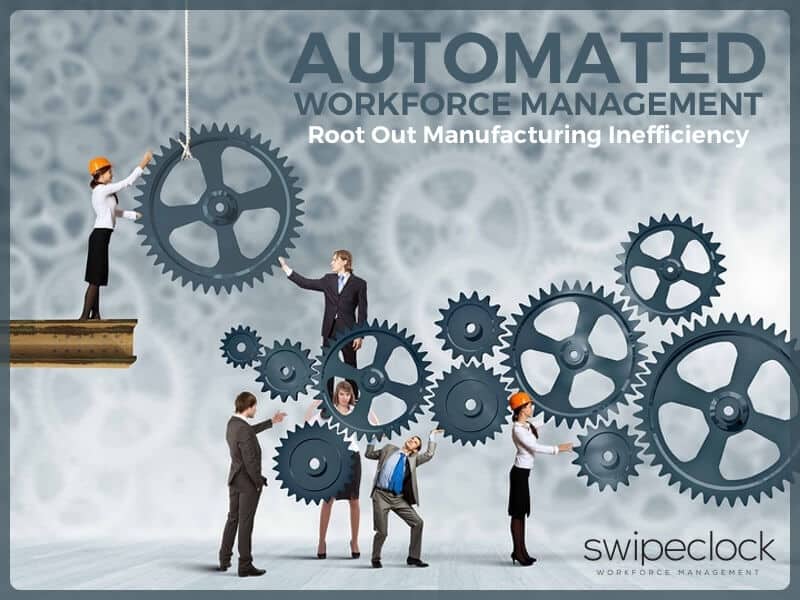Automated Workforce Management: Root Out Manufacturing Inefficiency

Think your operations are running lean? If you haven’t automated workforce management, you could be much leaner.
How Does Automation Reduce Inefficiency?
- Improve workflows
- Reduce time spent on non-billable tasks
- Data for ongoing analysis and improvement
- Make all employees more effective
Automated Systems Are Getting More Powerful
Basic automated systems combine employee time and attendance and scheduling. Larger systems are expanding to include everything else the Human Resources department handles. Employee onboarding, performance reviews, and engagement programs, for example. With payroll tools, manufacturers can bring it back in-house and do it better and cheaper. Document and manage workflows. When a system can integrate with third-party industry apps, its capability is limitless.
Manufacturers are turning to cloud-hosted systems because they eliminate the problems of premise-based software. They are generally cheaper and more convenient. Staff at multiple locations can easily access the same system. They scale easily and don’t require software updates. Manufacturers who use cloud-based systems outsource the data security functions to the vendor.
Let’s discuss some ways manufacturers can cut inefficiency with automated workforce management.
Eliminate Timekeeping Redundancy
With manual timekeeping, workers fill out time cards. Then a supervisor approves them. A payroll manager enters the hours into the payroll system or sends them to the payroll service. These processes can be done far better with automation. The supervisor can approve hours at a glance. Timesheets can be accessed quickly and have far fewer errors. Searchable databases streamline the process.
Scheduling Drives Productivity
Workforce management systems let you proactively manage employee scheduling. Scheduling becomes a tool for efficiency rather than an exercise in frustration. Smart employee scheduling is necessary for maximum productivity.
Self-service scheduling with an online portal transfers shift trading to the employees. Employees who want more hours bid on open shifts. All parties can see the schedule updates as they happen. Increased employee control boosts morale and engagement.
You can read more about employee self-service here: Employee Self-Service Can Save Your Sanity.
Scheduling Integrated With Time Tracking
- Make and modify schedules quickly and easily
- Track certifications with job codes
- System automation finds eligible workers to cover open shifts
- Customized system warnings reduce over-staffing and unplanned overtime
- Mobile access for HR, supervisors, and employees
- Employees manage time cards, shift trades, and PTO at one point of access
- Creates and maintains audit-ready records
- Integrates with payroll
- Analyze data to make better decisions
Simplify Overtime Compliance
Manufacturers can’t focus solely on Occupational Safety and Health Act (OSHA) compliance. The Fair Labor Standards Act (FLSA) demands attention, as well. Namely, overtime requirements.
Manufacturers violate overtime laws for many different reasons. Employers in a cash crunch may withhold overtime pay. Overtime laws are pretty cut and dried with little wiggle room. The Department of Labor (DOL) has no trouble prosecuting and imposing costly fines.
Employees who aren’t paid overtime can easily file a complaint with the DOL. It only takes one complaint for the owner to become the subject of an in-depth audit.
For most small manufacturers, overtime is a controllable expense. If they can’t eliminate it completely, they can reduce it. Managing overtime for 24-hour facilities is complicated.
Automated workforce management systems have tools for overtime compliance. Supervisors set alerts so that overtime can be avoided or proactively managed. Overtime alerts ensure that all employee overtime is approved in advance.
When supervisors don’t have to keep an eye on the clock, they can keep their eyes on the production line.
Easy Access To All HR Information
Manufacturers who automate benefit from centralized information management. When the system is cloud-based, all players can access anything they need from any mobile device. Searchable databases save time and frustration day after day.
Instill an Improvement Mindset
The importance of company culture cannot be overstated. “Culture eats strategy for breakfast.” (Attributed to Peter Drucker.) Automated workforce management creates a culture of continual improvement for any size manufacturer.
Forward-thinking owners are never satisfied with the status quo. Smart automation speaks louder than the Six Sigma book on your desk. A dedication to accuracy and productivity comes from the top down.
Automated workforce management compiles data that increases in value over time. This data is a vehicle for collective analysis and problem-solving.
Smartly-designed systems show your employees that you value best practices. You are not going to be a small manufacturer for long. You are planning to become a major player and compete in global markets.
Automated systems let you include employees in improvement processes. It provides an easy way to communicate problems and suggest solutions. All teams can evaluate the results in a centralized forum. Everyone is speaking the same language regarding metrics and desired outcomes.
Improve Document Management
Manufacturers understand the value of eliminating waste in production operations. There are equally valuable benefits in cutting waste in Human Resources.
Your HR engine runs on documents. Efficient document management can only be achieved with advanced workforce management systems. Admin processes are well-defined. This makes them uniquely suited to automation.
Automate Onboarding
Most manufacturers are somewhat familiar with how automated employee timekeeping works. Let’s look at a relatively new feature appearing in the industry.
Some of the latest automated systems incorporate onboarding. It’s surprising that this function has remained a manual process in so many companies. Many manufacturers with automated systems are still doing onboarding the old-fashioned way. It’s time-consuming and vulnerable to error.
Paperwork in the form of actual paper has no place in any 21st-century business that wants to root out inefficiency.
With automated onboarding, the new hire must complete each document in order to move on to the next one. The system prompts the employee if a field is left blank. Forms can’t be lost or misplaced. Sensitive information is never unprotected.
Process tracking and completion confirmation let the HR manager know where a new hire is in the process. It also streamlines compliance.
HR managers, supervisors, and employees can retrieve a document with a one-click search. No one has to rummage through a filing cabinet to locate a document.
Updating a form or adding a step to the process is quick and easy. This is extremely handy if the document happens to be a 200-page policies and procedures manual.
Reduce HR Costs
What about lowering labor costs? When describing the pros of automation, this is usually the benefit most often cited. The labor cost savings are still key to the new expanded systems. They are especially evident when it comes to administrative costs.
The human resources department does not directly generate revenue. Reducing the cost of admin stretches your profit margin without lowering productivity.
Want to Grow? Automate.
Let’s look at a real-world example. An 8-person trailer manufacturer added 72 employees and two plants in under a year. They credit automated workforce management for capably handling the rapid growth. They praised the ease-of-use, scalability, and payroll accuracy. It now takes less time to manage 80 employees that it took to manage the original eight. To learn more about their story, see SwipeClock for Manufacturing.
WorkforceHUB For Manufacturing
SwipeClock is leading the industry in manufacturing workforce management. WorkforceHUB is the new employee portal from SwipeClock. It has everything you need to manage your employees:
- Time and attendance
- Scheduling
- Payroll
- Onboarding
- Employee engagement
To learn how WorkforceHUB can save you 22% in administrative expenses, visit WorkforceHUB For Manufacturing.
By Liz Strikwerda
Simplify HR management today.
Simplify HR management today.
Navigating the Complexities of Healthcare Recruitment
The healthcare sector is renowned for its rewarding nature, offering professionals the chance to significantly impact individuals’ lives by aiding in their recovery from various ailments and conditions. However, for those tasked with recruitment within this sector, the challenges are plentiful. Delve into our in-depth guide for an array of strategies to elevate your healthcare…
Read MoreThe Importance of Facial Recognition Time Clocks for Small Businesses
Updated April 17, 2024 A facial recognition time clock is no longer a luxury. Advanced biometric clocks are a must-have for today’s workplaces. A facial recognition time clock is the best technology for tracking employee time. It solves a multitude of problems employers are facing with their workforces. What is a Facial Recognition Time Clock?…
Read More





